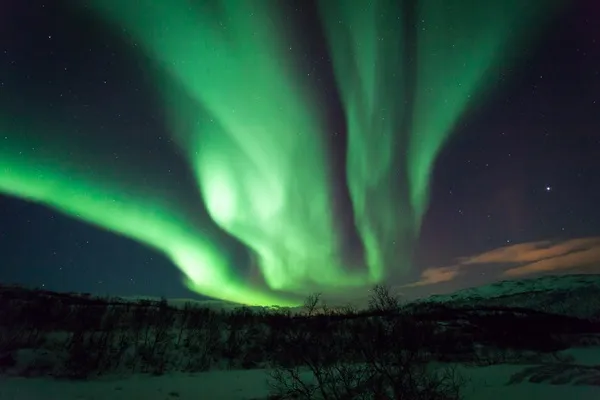Ancient semi-fossilized tree rings may hold the clues to the largest solar flare event ever known, which occurred some 14,000 years ago, according to researchers.
The researchers investigated “subfossils,” which are particle fossilized biological material, from a forest in the Southern French Alps. They sliced the tree samples into hundreds of single tree-rings and analyzed each of them, giving them a nearly annual accounting of the conditions those trees experienced thousands of years ago. In particular, the researchers were measuring the relative amount of carbon-14, a radioactive isotope of the familiar element that decays with a half-life of 5,730. Most of the carbon-14 on the Earth is generated when energetic particles from space hit the molecules of the upper atmosphere, and so the carbon-14 measurements can be used to age the subfossils and to look for any anomalies.
An ancient surge in carbon-14
And the researchers were surprised when they discovered one significant anomaly: a radical one-year spike in carbon-14 that occurred 14,300 years ago. Searching for an explanation for this anomaly, the researchers turned to ice core samples taken from Greenland, which showed a spike in a radioactive isotope of beryllium around the same time.
There’s only one known plausible mechanism that can generate that much radioactive carbon and beryllium in such a short amount of time: a solar flare. But this can’t be any normal solar flare, but one of truly epic proportions.
No known solar flares have made a significant increase in atmospheric radioactive elements. But we’ve only been recording solar flares for a relatively short amount of time.
Edouard Bard, a Professor of Climate and Ocean Evolution at the Collège de France and CEREGE, and lead author of the study, said in a news release, “Direct instrumental measurements of solar activity only began in the 17th century with the counting of sunspots. Nowadays, we also obtain detailed records using ground-based observatories, space probes, and satellites. However, all these short-term instrumental records are insufficient for a complete understanding of the Sun. Radiocarbon measured in tree-rings, used alongside beryllium in polar ice cores, provide the best way to understand the Sun’s behavior further back into the past.”
The Carrington Event shocked, literally and figuratively
The most powerful measured solar flare event occurred in 1859. Known as the Carrington Event, the solar storm drove aurorae to be visible as far south as Cuba, and telegraph operators reported getting shocked by their devices – a consequence of the extreme electromagnetic energies produced by the storm. To generate the recorded amount of carbon-14, the event 14,300 years ago must have been at least ten times more powerful.
Energetic events like this are the result of magnetic fields in the Sun snapping, releasing their pent-up energy. This causes a flare, which is a burst of intense x-ray radiation, along with the release of a coronal mass ejection, which is when chunks of plasma hurl themselves off the Sun and go flying through the solar system.
This is not the first time that researchers have identified giant solar flares using tree ring records. Known as Miyake events, after Japanese physicist Fusa Miyake, there are five confirmed and an additional four possible spikes in carbon-14 recorded in tree ring data. While none of these were as powerful as this new event, some of them did occur during recorded history.
For example, the Anglo-Saxon Chronicle recorded in 774 CE that, “This year also appeared in the heavens a crucifix, after sunset,” which may be an aurora associated with a strong solar flare that we know about from carbon-14 tree ring data. Another event, in 992 CE, was associated with Korean astronomical observations that “heaven’s gate” opened one night.
We’re lucky that we haven’t experienced such a strong storm since the development of electronics and electrical grids, which can be damaged by the extreme electromagnetism of a flare and coronal mass ejection.
‘Extreme’ solar storms can be catastrophic
Tim Heaton, a Professor of Applied Statistics in the School of Mathematics at the University of Leeds and a coauthor on the study, said, “Extreme solar storms could have huge impacts on Earth. Such super storms could permanently damage the transformers in our electricity grids, resulting in huge and widespread blackouts lasting months. They could also result in permanent damage to the satellites that we all rely on for navigation and telecommunication, leaving them unusable. They would also create severe radiation risks to astronauts.”
By pushing back in time our knowledge of strong solar events, we can better understand the extreme side of our energetic Sun, better predict for when the next storm is likely to arrive and prepare ourselves for when it hits.
“Radiocarbon provides a phenomenal way of studying Earth’s history and reconstructing critical events that it has experienced,” Heaton said. “A precise understanding of our past is essential if we want to accurately predict our future and mitigate potential risks. We still have much to learn. Each new discovery not only helps answer existing key questions but can also generate new ones.”
Credit: Astronomy

